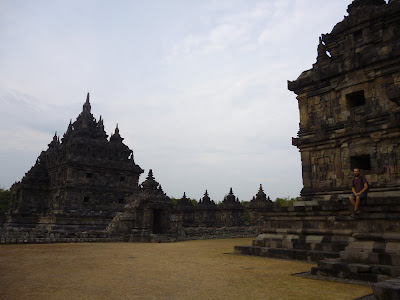Jogjakarta presume de ser el centro cultural de la isla de
Java, y no le faltan razones. Además de tener un centro urbano muy activo, y de
los más agradables de Indonesia (aunque eso no sea decir mucho), está cerca de
dos yacimientos declarados patrimonio de la humanidad por la UNESCO.
Se trata de dos conjuntos de templos hinduistas y budistas
muy bien conservados de los siglos VIII y IX. Son de lo poco que queda en
Indonesia de antes de la llegada del Islam.
Para visitar estos lugares alquilamos una moto y, una vez
fuera de la ciudad, fue muy fácil llegar (estaban muy bien indicados).
Primero visitamos Prambanan, 17 km al noreste de Jogjakarta.
Construidos entre los siglos VIII y X, son el mejor testimonio del pasado
hinduista de Java. El conjunto está dividido en cuatro zonas, con entradas y
precios diferentes. La entrada a la zona principal valía veinte dólares (un
dineral comparado con el precio simbólico que pagan lxs indonesixs) y como no estábamos
por la labor de pagarlos seguimos el consejo de una pareja de francesxs que nos
dijo que era posible entrar por la puerta de atrás.
Aparcamos la moto y nos acercamos a la puerta custodiada por
unos guardas. Nos pidieron dos euros por “aparcar” la moto, escribimos nuestros
nombres, y les dejamos claro que no íbamos a ver los templos principales
(mentira). Vimos solxs el Candi Sewu que fue el templo que más nos gustó. Debido
a la actividad sísmica de la zona los templos han tenido que ser reconstruidos
en varias ocasiones. En cuanto al Candi Sewu, se ha restaurado el templo principal
mientras que las estupas que lo rodean se han dejado en ruinas.
 |
| En el Candi Sewu. |
 |
| La entrada al Candi Sewu. |
Entramos al conjunto principal de templos por la salida desprovistxs
del obligatorio sarong que llevaba todo el mundo. Tuvimos la suerte de
cruzarnos con una pareja que salía y nos prestó amablemente sus sarongs (prenda
hinduista imprescindible para visitar los lugares sagrados). Lo que más nos llamó
la atención fue la altura de los templos (47 metros el más alto) y la riqueza de los grabados en la piedra.
 |
| Andrea con el conjunto principal de templos. |
 |
| Relieve del Candi Shiva de Prambanan. |
 |
| Escena del Ramayana. |
 |
| El conjunto de templos de Plaosan. |
Al día siguiente fuimos a visitar Borobudur, una joya preservada
por las cenizas del Merapi durante siglos. Después terremotos y actos
terroristas han intentado destruir este monumento sin éxito.
Ahora tiene nuevxs enemigxs: lxs indonesixs de a pie. Nos entraban
ganas de llorar al ver a la gente subirse a las estatuas de los budas, darle goles
a los relieves, tirar basura por todas partes, trepar por donde ponía no trepar,
sentarse donde ponía no sentarse, etc.
Es un lugar espectacular, pero lxs restauradorxs se están planteando
cerrarlo al público por el deterioro que está sufriendo.
 |
| Borobudur. |
 |
| En lo alto de Borobudur. |
Jogjakarta
boasts of being Java’s cultural centre, and they have plenty of reasons for it.
In addition to having a very active downtown, and one of the most pleasant ones
of Indonesia (even if that doesn’t mean much), it is close to two sites that
have been declared world heritage by the UNESCO.
It consists
of two compounds of Buddhist and Hindu temples very well preserved dating from
the VIII and the IX centuries. They are part of the few things that remain in
Indonesia before the arrival of Islam.
To visit
these places we rented a motorbike, and once out of the city, it was easy to reach
them (there were good signals around).
We first
visited Prambanan, 17 km Northeast of Jogjakarta. Built between the VIII and
the X centuries, they are the best testimony of Java’s Hindu past. The compound
is divided into four areas, each with their own entries and prices. The
entrance to the main area was twenty dollars (a fortune compared with the symbolic
price paid by Indonesian people) and because we weren’t very keen on paying the
money we followed the advice of a French couple that had told us that it was possible
to enter through the back door.
We parked
our motorbike and we approached the door guarded by a couple of security men.
They asked us for two euros to “park” the motorbike, we wrote our names, and we
assured them that we weren’t going to visit the main temples (not true). We saw
the Candi Sewu alone and it was the temple which we enjoyed the most. Due to seismic
activity the site has been rebuilt several times. As for the Candi Sewu, only
the main building has been restored, leaving the stupas that surround it in
ruins.
We entered
the main complex of temples through the exit devoid of the compulsory sarong
that everyone had to wear. We were lucky to cross a couple that was going out
and lent us their sarongs (a garment that has to be worn to visit Hindu sacred places).
The things that impressed us most were the height of the temples (47 metres the
highest one) and the quality of the rock carvings.
The next
day we went on to visit Borobudur, a jewel preserved thanks to Merapi’s ashes
for centuries. Afterwards, earthquakes and terrorist acts have tried to destroy
this monument without succeeding.
Now it has
new enemies: normal Indonesian people. We wanted to cry when we saw the people
climbing on to the Buddha statues, hit the carvings, throw rubbish everywhere,
climbing where it was written not to climb, sitting where it was written not to
sit, etc.
It is an
amazing place, but restorers are thinking to close it for the public due to the
erosion that is suffering.

No hay comentarios:
Publicar un comentario